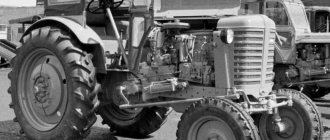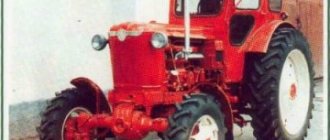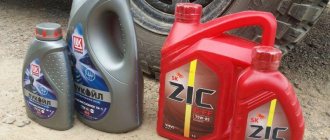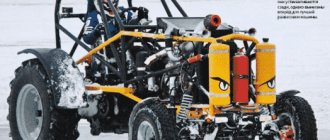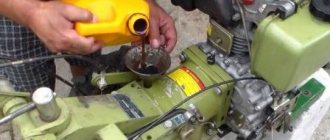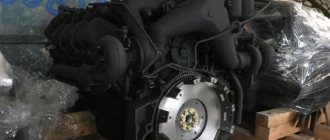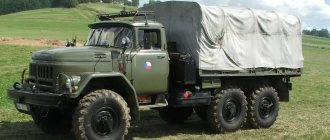- home
- Brands
- GAS
29.05.2020
GAZ-3307 is a family of Soviet and Russian trucks, which belongs to the fourth generation of medium-duty vehicles of the Gorky Automobile Plant. The production years of the onboard model with a gasoline engine are from 1989 to 2022, and the diesel version has been produced since the end of 1994. The family of the same name replaced the outdated third generation GAZ-52/53 line, which left the assembly line in 1993. The new family included vehicles with a load capacity of up to 4,500 kg. The cars were intended for cargo transportation on any roads, including light off-road conditions. In addition to gasoline versions, the line also included the GAZ-4301, capable of transporting up to 5 tons. There was also a version 3306, as well as the all-terrain model 3308 “Sadko”.
How much oil to put on the lawn?
Characteristics of YaMZ-534
| Production | "Avtodiesel" Yaroslavl Motor Plant |
| Fuel consumption at a speed of 60 km/h, l/100 km (for GAZon Next) | 13.6 |
| Oil consumption , % of fuel consumption, up to | 0.1 0.2 (5342, 5344, 5345) |
Engine oil | 5W-40 10W-40 15W-40 |
| How much oil is in the engine, l | 13.5 |
Main modifications of the GAZ-3309 car
At the very beginning, the technical characteristics of the GAZ-3309 included a four-cylinder engine with a diesel operating principle based on the GAZ-5441.10 developed by the enterprise. The power of the running gear was 122 hp, and the effective volume was 4.75 liters. The next engine of the GAZ-3309 model was the equipment of the D-245.7 model. It is a classic four-cylinder engine with an installed turbocharger, the volume was 4.75 liters, and the power was only 117 hp. Since 2013, the vehicles have been equipped with a YaMZ-53442-10 diesel engine. The functional volume of the unit is 4.43 liters, and the power is 134.5 hp. The equipment complies with the accepted environmental standard Euro-4.
Vehicles from are actively used to ensure the transportation of various types of cargo and the ability to move on any type of road surface. The classic chassis provides the ability to install vans, isothermal chambers, garbage trucks, special manipulators, dump trucks and other structures.
What kind of oil should I pour into the gazelle axle?
As experienced Gazelle
, for
gearbox,
transmission
oil
from almost any manufacturer with a viscosity of 75W90 or 80W90 is suitable. For example, this could be Liqui Molly 75W90 or Shell Spirax S3. A complete replacement usually requires a little more than 3 liters.
Interesting materials:
When can you wear a coat? When can you dig potatoes after flowering? When can you dig new potatoes after flowering? When can you bathe a child after a Mantoux reaction? When can you eat after inhalation with Pulmicort? When can you change tires to summer ones? When can you go to the cemetery? When can you start wearing a down jacket? When can you start washing your husky puppy? When can you start wearing a spring jacket?
History of creation and development [ edit | edit code ]
Work on the creation of a new generation of medium-duty trucks of the GAZ brand to prospectively replace the previous GAZ-53A family began in the second half of the 1960s. At first, it was planned only to modernize the model produced by the plant. In 1972, prototypes of such a truck were built and designated GAZ-53-11.
.
The cars featured new tail panels and cabin interiors. They passed the tests, but it became clear that a completely new model was required [ source not specified 361 days
]. At this time, heavy trucks of the Magirus-Deutz brand from the West German concern Klöckner-Humboldt-Deutz began to arrive in the USSR. And although by Western standards these cars were not so outstanding, they made an impression on Soviet specialists; air-cooled diesel engines proved themselves to be excellent in the harsh conditions of Siberia. And the XXV Congress of the CPSU, held in February-March 1976, decided to begin the mass dieselization of the USSR truck fleet. It was decided to make the promising generation of GAZ trucks diesel and not just, but with air-cooled diesel engines. The engine of the German truck and its spacious cabin had a significant influence on the plan of the Gorky residents. Negotiations began with the Germans on the terms of purchasing a license for the production of air-cooled diesel engines.
The technical design of the new truck, designated GAZ-4301, was reviewed by the scientific and technical council of the Ministry of Automotive Industry on February 9, 1978. The work on the new machine was led by engineer Alexander Mikhailovich Butusov. Leading designer Valery Dmitrievich Zapoynov, designer Stanislav Vitalievich Volkov. The first prototypes were built in 1979. The second series of experimental machines was completed in 1981.
The car received a more spacious modern double cabin, equipped with an effective ventilation and heating system, first used on the experimental GAZ-4301 truck in 1984. The steering design, unlike its predecessors, includes power steering for the first time.
Modifications
Based on the basic GAZ-33 model with serial index 07, modifications with the following digital designations were created:
- 330701 - version for work in northern latitudes;
- 330706 - export vehicle for use in temperate climates;
- 330707 - product for export to tropical countries;
- 33072 - dump truck;
- 33073 - a cargo-passenger version with an on-board platform from the GAZ-66-11, released in 1993, and standard technical characteristics;
- 33074 - bus version;
- 33075 - a machine with an engine running on liquefied gas from installed cylinders. Not transferred to mass production;
- 33076 - another gas-cylinder version using a compressed gas mixture, also not mass-produced;
- 33078 - a car with a Hino W04CT diesel power plant, not widely used.
In addition to the listed modifications, after additional improvement of the GAZ-3307, the GAZ-3308 and 3309 models were released, with various versions, the GAZ-SAZ-4509 dump truck for agricultural work, etc.
Photos and technical characteristics of various modifications of the GAZ-3307 are widely presented on the Internet.
GAZ-33074 - bus version
Description of design
The GAZ-3307 truck is based on a frame consisting of two stamped side members and cross members. The parts are connected to each other with rivets. An engine is installed on the front of the frame, equipped with two front and two rear supports.
The truck is equipped with a front tow bar that consists of king pins that fit into the holes of the tow forks.
The fixation of the pins is spring-loaded. A towing hook is mounted on the rear cross member of the frame.
The axles of the GAZ-3307 truck are attached to the frame through longitudinal springs that have a semi-elliptical shape. The front suspension has springs complemented by a pair of hydraulic telescopic shock absorbers. The ends of the springs are embedded in rubber support pads.
The rear springs are supplemented by suspensions, which work when the car is loaded or when driving on uneven roads. The front axle of the truck is a forged beam, at the ends of which there are steering knuckles. The connection between the beam and the knuckles is a pin connection.
The bulk of the GAZ-3307 came off the assembly line with GAZ-53 type rims (with three windows). But some of the cars of the simplified model 33061 were equipped with wheels from the GAZ-51 - with six windows.
Price of new and used GAZ 3307
Cars of the GAZ 3307 line are still in demand. New models are produced exclusively to order in single batches. The cost of the machine will depend entirely on the selected add-on. The most common versions are van and board. The starting price tag for an onboard model starts from 700,000 rubles, for a van – from 850,000 rubles. Lifts on a similar base will cost much more – from 1.1 million rubles. Additional options may raise the price tag slightly.
A used version of GAZ 3307 will help you save money when purchasing. However, there is a risk of buying problematic equipment, of which there is plenty on the market. Depending on the modification, condition and year, price tags for a working model range from 100,000 to 300,000 rubles. The cost of versions 2014-2016 can reach up to a million.
Engines for GAZ-3309 and their technical characteristics
D-245.7
| Type | 4-stroke, turbo diesel |
| Cylinders | 4-cylinder, in-line |
| Working volume | 4.75 l. |
| Power | 119 hp |
| Torque | 413 Nm |
| Crankshaft rotation | right |
| Cylinder diameter*piston stroke | 110*125 mm. |
| Compression ratio | 17 |
| injection pump | Bosch CP3 or YAZDA 833.1111005.01 |
YaMZ-53442-10
| Type | 4-stroke, turbo diesel |
| Cylinders | 4-cylinder, L-shaped |
| Working volume | 4.43 l. |
| Power | 136 hp |
| Torque | 422 Nm |
| Nominal fuel consumption | 145 g/hp.h. |
| Compression ratio | 17,5 |
The gearbox for both engines is the same - it is a manual 5-speed gearbox, bevel, hypoid type, with a single-plate dry clutch. Gear ratio 4.556.
What motor oils and fluids to use
For the lubrication system, it is recommended to use all-season oil M-8V or M-6/10V. But if you work in severe frosty conditions, then you will need ASZp-6 oil. For the gearbox, it is better to use all-season oil TAP-15v, from minus 25 to minus 30, use TSp-10, and if the temperature is even lower, then fill in TSp-15K with a small addition of diesel fuel for diesel gas 3307. The same oils Can also be used for steering gear. The main gear housing should be filled with all-season oil TSp-14gip; in very severe frosts - TSz-9gip. For shock absorbers you will need AJ-12T fluid, or spindle oil. Use Tom as brake fluid.
Universal truck GAZ 3309 for commercial use
The rational arrangement of all controls fully complies with recognized international standards, and the instrument panel has also undergone changes. The seats are adjustable in several ways and equipped with seat belts; it is possible to independently install high sides and an awning.
Three low folding sides, which were originally equipped with the GAZ 3309 car sold at LLC, speed up and facilitate the process of loading and unloading it; the floor height of 1365 mm does not make it difficult to manipulate heavy objects. The car is equipped with either a 4-cylinder diesel engine or a slightly outdated petrol 8-cylinder V-shaped engine, to choose from. The popularity of the diesel engine ensures high torque and compliance with the Euro-3 standard, which is why we offer this option. A vehicle equipped with a gasoline unit does not meet emission standards; its torque is almost half that of diesel models.
Device
GAZ 3307 has a both simple and thoughtful design. The truck unit is complemented by a reliable transmission. A 4-speed manual transmission works in conjunction with dependent suspensions, represented by a set of gears and shafts. Gear shifting is realized through the clutch. The transmission housing has secondary and primary shafts. The latter is connected to the flywheel of the power plant, the first controls the rotation of the wheels. To control 1st and 2nd gears, a switch lever is used, 3rd and 4th – a clutch. Oil is also poured into it and drained. The filling hole is located on the side of the cast iron body, and the drain hole is at the bottom. An indicator of the end of pouring is a hole made on the side of the body. When excess liquid begins to flow from it, the filling must be completed.
Features and operation
The designers, while developing the GAZ-3307 model, achieved an increase in the degree of cabin comfort, with a significant increase in the total volume. The walls of the doors have convenient niches for storing equipment and personal items. The noise and thermal protection of the cabin has been significantly improved.
On a note! All modifications of the truck are characterized by a high degree of unitarity, which greatly facilitates maintenance and repair. Enterprises operating such machines have the opportunity to profitably purchase the necessary spare parts produced by the manufacturer. Cooperation with the Minsk Automobile Plant made it possible to arrange the supply of reliable diesel engines.
11.7. Operating materials
| Name of fuel, oil, lubricant, working fluid | GOST, OST or TU |
| Gasoline "Normal-80" (GAZ-3307) | GOST r 51105–97 |
| Regular-92 (duplicate) - GAZ-3307 | GOST r 51105–97 |
| Diesel fuel (GAZ-3309) | GOST r 52368–2005 |
| TNK Motor Oil oil (GAZ-3307) | TU 38.310–41–148–01 |
| Ufalube oil (GAZ-3307) | TU 38.302.032–90 |
| Ufalyub-Lux oil (GAZ-3307) | TU 0253.004.0576654–96 |
| Angrol oil (GAZ-3307) | TU 38.601.01.220–92 |
| Lukoil Standard oil | TU 38.601–07–21–02 |
| Oil "Yar-Mark" 1 and 2 (GAZ-3307) | TU 38.301.25.19–95 |
| Oil "Yar-Marka" Extra (GAZ-3307) | TU 38.301.25.36–97 |
| Samoil oil (GAZ-3307) | TU 38.301.12002–94 |
| Wells oil 1 and 2 (GAZ-3307) | TU 0253.072.00148636–95 |
| Oil “Standard-3”, “Standard-5” (GAZ-3309) | TU 38.301–19–79–98 |
| Lukoil-Standard oil (GAZ-3307) | TU 38.301–29–77–95 |
| Oil "Spectrol" (GAZ-3307) | TU 0253.003.069113380–95 |
| Oil "Ferganol" (GAZ-3307) | TU uz.39.3–145–96 |
| Oil "NaftanMB" (GAZ-3307) | TU rB 057784770–90 |
| Lukoil Avangard oil (GAZ-3309) | TU 025–075–00148636–99 |
| Lukoil Super oil (GAZ-3309) | TU 025–075–00148636–99 |
| Oil "Yukos Plus" (GAZ-3307) | TU 0253–003–48120848–01 |
| Oil "Consol Standard" (GAZ-3307) | TU 0253–017–17280618–2001 |
| Oil m-8V (GAZ-3307) | GOST 10541–78 |
| Oil m63/10B (GAZ-3307) | GOST 10541–78 |
| Oil m43/6V1 (GAZ-3307) | GOST 10541–78 |
| Oil m10G2 (GAZ-3309), M10G2K (GAZ-3309) | GOST 8581–78 |
| Oil m8G K (GAZ-3309) Oil m10DM (GAZ-3309) | GOST 8581–78 |
| GOST 8581–78 | |
| Oil m8DM (GAZ-3309) | GOST 8581–78 |
| Oil tAP-15V | GOST 23652–79 |
| TSP-15k oil | GOST 23652–79 |
| Oil “Super T-3” (TM5) | TU 38.301–19–62–01 |
| Oil "Devon Super T" (TM-18) | TU 0253–035–00219158–99 |
| Lukoil TM-5 oil SAE 85W-90 | TU 38.601–07–23–02 |
| Lukoil TM-5 oil SAE 75W-90 | TU 38.601–07–23–02 |
| TSP-10 oil | GOST 23652–79 |
| TCP-9 hyp oil | TU 38.1011238–89 |
| Castor oil | GOST 6990–75 |
| Oil for hydromechanical and hydrostatic transmissions, grade “R” (GAZ-3309) | TU 38.101.1282–89 |
| Oil for hydromechanical and hydrostatic transmissions, grade “A” (GAZ-3309) | TU 38.101.1282–89 |
| VMGZ oil (GAZ-3309) | TU 38.101.479–00 |
| Spindle oil AU | TU 38.1011232–89 |
| Shock-absorbing liquid АЗ-12т | GOST 23008–78 |
| Gun grease (PVC) | GOST 19537–83 |
| Litol-24 lubricant | GOST-21150–87 |
| Solid oil lubricant | GOST 1033-.79 |
| Grease Solidol C | GOST 4366–76 ' |
| Grease CIATIM-201 | GOST 6267–74 |
| Grease No. 158 | TU 38.301–40–25–94 |
| Lita grease | TU 38.1011.308–90 |
| Graphite lubricant USSA | GOST 3333–80 |
| Brake fluids: | |
| "ROSDOT" | TU 2451–004–36732629–99 |
| "Tom" class III mark "A" | TU 2451–076–05757618–2000 |
| Automotive cooling fluids: | |
| Tosol-A40M, 'Tosol-A65M | TU 6–57–95–96 |
| OZH-40 “Lena”, OZH-85 “Lena” | TU 113–07–02–88 |
| "Cool Stream Standard" | TU 2422–002–13331543–2004 |
| "Thermosol" | TU 301–02–141–91 |
Appendix 8
Engine repair
The power units used in the design of this model are highly reliable and relatively rarely require repairs. If any malfunctions are identified, eliminating them is not difficult, which is due to the availability of many spare parts for the GAZ 3307 for sale.
Major renovation
If necessary, the engines used in the design can be overhauled, which will allow them to be restored to their original operating condition in the presence of numerous malfunctions. To do this, it is advisable to adhere to the following algorithm:
- Wash and disassemble the power unit, identifying worn parts and components.
- Repair the cylinder block.
- Grind the crankshaft and clean the oil system. If the degree of wear is high, it is advisable to replace the part.
- Replace other elements with a high degree of wear.
- Assemble the unit with new components.
- Adjust the valves and run the engine using a special stand.
- Install the motor on the car.
After the unit has been successfully installed on the machine, you will need to check the integrity of the cooling system by pouring water into it. If there are no leaks, it is advisable to drain it and replace it with antifreeze/antifreeze. In addition, it is necessary to fill the engine oil.
Partial renovation
If the engine does not have multiple breakdowns, partial repairs are allowed, involving the elimination of a small number of faults. Most often, the cylinder block, valves, and piston rings require repair. If serious damage is detected that cannot be eliminated by other methods, the elements should be replaced.
One of the most common breakdowns is a malfunction of the oil pump, which can be eliminated by replacing it. This procedure is extremely simple, since access to the desired node is carried out without any obstacles. The element is located next to the flywheel housing.
If the engine exhibits unstable operation, often stalls and twitches when moving, most likely there is an air leak due to the loss of tightness of the gasket. To fix it, you will need to dismantle the exhaust manifold, replace the damaged gaskets with new ones and reinstall the unit.
Dimensions of the car
The truck has the following overall dimensions (in millimeters):
- total length - 7850;
- car width - 2340, with cabin doors open - 3350;
- track width - 2210, at the centers of the vertical axes of the wheels - 1800;
- height - 2400;
- body dimensions - 5000 by 2380;
- the distance between the front and rear axles is 4570.
The indicated dimensions are for on-board design. The length of the dump truck is slightly shorter - 6330 mm. The minimum ground clearance (from the rear axle) is 265 mm.
Maintenance and faults
Maintenance of diesel power units that are installed on the GAZ 3307 is carried out every 15,000 km. So, during the process, the engine oil, coarse and fine lubrication filters, as well as fuel filter elements are changed.
Many car enthusiasts often ask the question - how much oil is in the YaMZ 534 and MMZ D245 engines? According to the technical documentation, maintenance will require from 5.5 liters to 6 liters.
As for the gasoline brother, maintenance is recommended every 12,000-15,000 km.
If the vehicle is equipped with a gas cylinder installation, which is quite common, then it is necessary to reduce the service interval to 12,000 km.
Like any other power units, GAZ 3307 engines have problems. Thus, most often high-pressure fuel pumps fail on diesel engines, since it is difficult to find good fuel in the CIS. Moreover, as practice shows, no one tries to pour high-quality fuel into cargo lawns. Also, bad fuel leads to dirty injectors, which require additional care and maintenance.
The same fate awaits its gasoline counterpart ZMZ 523. The most common breakdown is the failure of the carburetor, which begins to flood the cylinders. This is due to the fact that the needle inside the injection device gets stuck, which leads to a number of problems.
In addition, thermostat failure becomes an eternal disease, as a result of which the engine often begins to overheat, and this inevitably brings its overhaul closer.





